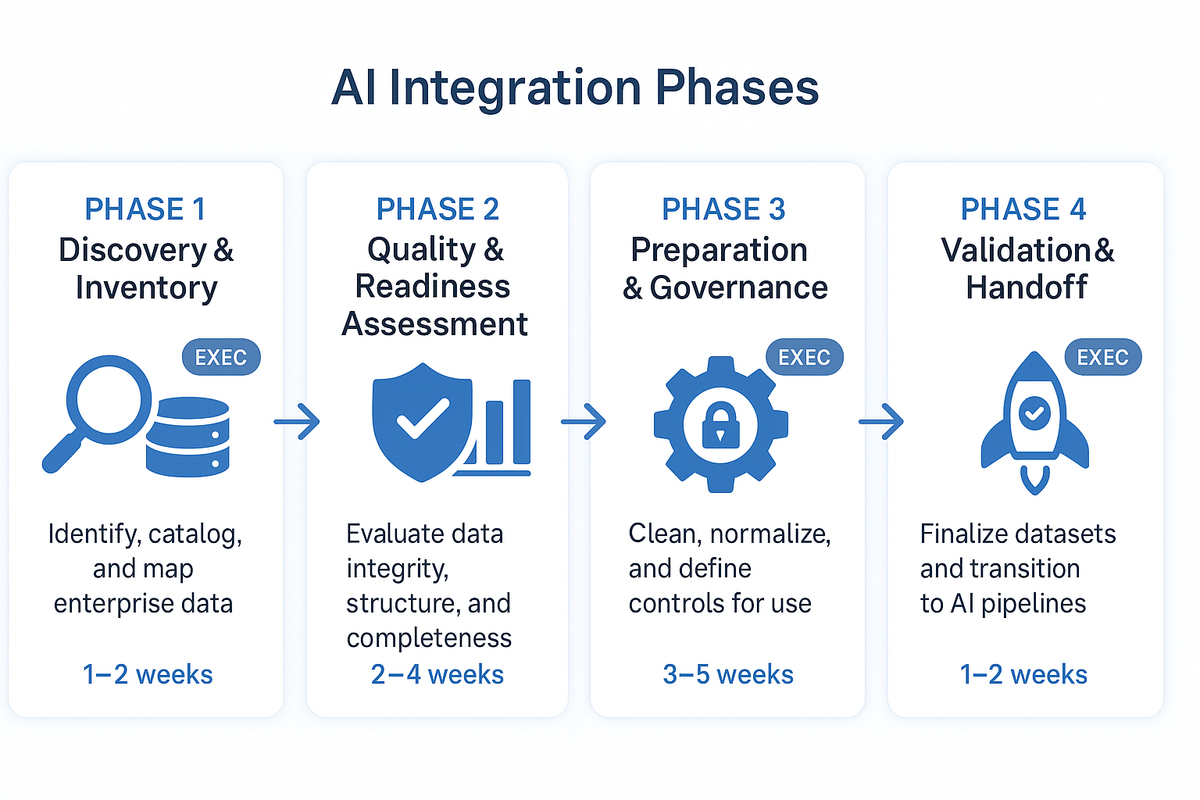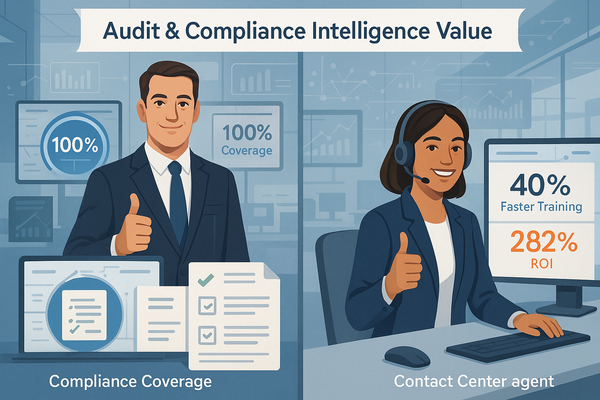Enterprise AI Data Preparation: The Executive's Guide to Avoiding the 30% Failure Rate

🎯 Executive Summary: Poor data quality causes 30% of enterprise AI projects to fail, costing organizations millions in abandoned initiatives. However, systematic data preparation using our 4-phase framework reduces failure risk by 70% and accelerates AI implementation timelines. This executive guide provides the strategic oversight framework and project management blueprint needed to ensure your AI initiative has the data foundation for success.
📊 The Data Reality Check: Why 30% of AI Projects Fail
The statistics are stark: between 70-85% of AI initiatives fail to meet their expected outcomes, with Gartner specifically noting that "30% of GenAI projects will be abandoned after proof of concept by the end of 2025, due to poor data quality, inadequate risk controls, escalating costs or unclear business value."
The Root Causes of Data-Related AI Failures:
- Format Incompatibility: Organizations have "plenty of data – stored in lakes, warehouses, internal tools – but not in a format that's usable for training"
- Governance Blind Spots: "Nearly two-thirds (64%) of organizations lack full visibility into their AI risks"
- Measurement Framework Gaps: Projects fail because "unclear business objectives" and lack of "well-defined KPIs for gen AI solutions"
- Skills Gap Reality: "43% cite lack of technical maturity and 35% shortage of skills and data literacy" as primary obstacles
The Executive Challenge: Most business leaders understand AI's potential but lack a clear framework for ensuring their data is AI-ready. This guide provides that framework.
🗺️ The 4-Phase Data Preparation Process Map
This process map is designed for business executives to understand and project managers to execute. Each phase includes executive checkpoints and clear deliverables.
Phase 1: Data Discovery & Inventory
Executive Question: "What data do we actually have, and where is it?"
Critical Prerequisite: Use Case Definition Before data discovery begins, clearly define what your AI will actually do:
- What specific business process will the AI support or automate?
- What decisions will it make or assist with?
- What outputs and accuracy levels are required?
- Which departments and workflows will be impacted?
Without clear use case definition, teams waste time cataloging irrelevant data instead of focusing on what's actually needed for your AI application.
Process Overview: Your project manager leads a cross-functional team to catalog relevant enterprise data sources (based on defined use cases), assess current accessibility, and identify data ownership across departments.
Key Activities:
- Use Case-Driven Data Mapping: Inventory data sources relevant to your specific AI application (not all enterprise data)
- Ownership Documentation: Identify who controls each relevant data source and approval processes
- Access Assessment: Evaluate current data accessibility and integration capabilities
- Volume & Velocity Analysis: Understand data quantity and update frequency for AI requirements
Executive Checkpoint Deliverables:
- Complete data inventory with source locations and ownership
- Access permission matrix showing what data is immediately available
- Integration complexity assessment for each major data source
- Preliminary timeline for data access based on current systems
Success Criteria:
- 100% of relevant business data sources (for defined use cases) identified and documented
- Clear understanding of data access approval processes
- Realistic assessment of technical integration requirements
Phase 2: Data Quality & Readiness Assessment
Executive Question: "Is our data clean enough and legally usable for AI?"
Process Overview: Technical teams evaluate data quality, compliance status, and AI-readiness while business stakeholders define success metrics and use case requirements.
Key Activities:
- Quality Profiling: Assess data completeness, accuracy, and consistency across sources
- Compliance Verification: Ensure data usage complies with applicable US regulations:
- Federal Sector-Specific: HIPAA (healthcare), PCI-DSS (payment processing), FCRA (credit/employment decisions), SOX (financial reporting), GLBA (financial services)
- State Privacy Laws: CCPA/CPRA (California), VCDPA (Virginia), CPA (Colorado), and other state laws that exceed federal protections
- Industry Standards: NIST AI Risk Management Framework guidelines
- AI Compatibility Analysis: Evaluate if data formats and structures work with target AI platforms
- Business Metrics Definition: Establish clear, measurable AI success criteria before technical work begins
Executive Checkpoint Deliverables:
- Data quality report with specific issues identified and remediation costs
- Legal/compliance clearance for AI use cases with any regulatory restrictions noted (HIPAA, PCI-DSS, state privacy laws, etc.)
- Gap analysis showing what additional data or cleaning is required
- Defined business KPIs for AI success (ROI, efficiency gains, accuracy targets)
Success Criteria:
- Clear understanding of data quality investment required
- Legal approval for planned AI use cases
- Realistic assessment of additional data needs
- Business success metrics defined and agreed upon
Phase 3: Data Preparation & Governance Implementation
Executive Question: "How do we get our data AI-ready while maintaining security and compliance?"
Process Overview: Technical teams execute data cleaning and formatting while establishing governance frameworks that ensure ongoing data quality and security for AI operations.
Key Activities:
- Data Cleaning & Formatting: Remove duplicates, standardize formats, address quality issues identified in Phase 2
- Security Framework Implementation: Establish access controls, encryption, and audit trails for AI data usage
- Governance Policy Creation: Develop data usage policies, approval workflows, and compliance monitoring
- AI Platform Integration: Format and structure data for consumption by target AI platforms
Executive Checkpoint Deliverables:
- Clean, AI-ready datasets for initial use cases
- Implemented security controls and access governance
- Documented data preparation processes for ongoing operations
- Integration testing results showing AI platform compatibility
Success Criteria:
- Data quality metrics meet defined standards (typically 95%+ accuracy)
- Security and compliance controls operational and audited
- AI platforms can successfully consume prepared data
- Sustainable processes in place for ongoing data management
Phase 4: Validation & AI Implementation Handoff
Executive Question: "How do we prove this works and transition to production AI operations?"
Process Overview: Conduct pilot AI testing with prepared data, validate business outcomes against defined metrics, and establish ongoing monitoring and maintenance procedures.
Key Activities:
- Pilot AI Testing: Deploy limited AI use case with prepared data to validate technical functionality
- Business Outcome Validation: Measure pilot results against KPIs defined in Phase 2
- Production Readiness Assessment: Evaluate scalability and performance for full deployment
- Handoff Documentation: Create operational procedures for ongoing data management and AI operations
Executive Checkpoint Deliverables:
- Pilot test results demonstrating AI functionality with prepared data
- Business impact measurements against defined success criteria
- Production deployment plan with resource requirements and timelines
- Operational runbooks for ongoing data and AI management
Success Criteria:
- AI pilot demonstrates measurable business value
- Technical systems perform at required scale and accuracy
- Clear operational procedures for production deployment
- Team prepared for ongoing AI operations and data maintenance
⚡ Critical Success Factors for Business Executives
Executive Sponsorship Requirements
Your Role in Each Phase:
- Phase 1: Authorize data access across departments and resolve ownership conflicts
- Phase 2: Approve compliance frameworks and business metric definitions
- Phase 3: Secure budget for data preparation and governance technology investments
- Phase 4: Make go/no-go decision for production AI deployment based on pilot results
Budget Planning Framework
Typical Investment Breakdown:
- Data Assessment & Planning: 15-20% of total AI project budget
- Data Preparation & Cleaning: 30-40% of implementation costs
- Governance & Security Infrastructure: 20-25% of ongoing operational costs
- Team Training & Change Management: 10-15% for sustainable adoption
Timeline Expectations: Depending on your organization's data maturity, this process typically ranges from 6 weeks to 6 months. Organizations with mature data governance complete faster; those with fragmented data systems require more time for foundational work.
🔍 Common Data Preparation Pitfalls & Executive Solutions
Pitfall 1: Underestimating Data Integration Complexity
Warning Signs: Technical teams report "just need to connect a few databases" Executive Solution: Require detailed integration assessment in Phase 1 before budget approval Prevention: Budget 2-3x initial technical estimates for data integration work
Pitfall 2: Skipping Compliance and Governance Setup
Warning Signs: Teams want to "start with AI and add governance later" Executive Solution: Make governance framework a Phase 3 gate requirement Prevention: Require legal sign-off before any AI data processing begins
Pitfall 3: Unclear Success Metrics Leading to Scope Creep
Warning Signs: Teams can't define specific, measurable AI outcomes Executive Solution: Lock down KPIs in Phase 2 before technical work begins Prevention: Tie project funding to achievement of defined business metrics
Pitfall 4: Insufficient Change Management for Data Processes
Warning Signs: "The technology works but nobody uses it properly" Executive Solution: Include data stewardship training and process changes in project scope Prevention: Plan for 15-20% of budget dedicated to user adoption and training
💼 Executive Decision Framework
Phase Gate Approval Criteria
Use these criteria to determine if your project should proceed to the next phase:
Phase 1 → Phase 2 Gate:
- [ ] Complete data inventory with clear ownership identified
- [ ] Realistic integration timeline established
- [ ] No major legal or compliance blockers discovered
- [ ] Project team has necessary data access permissions
Phase 2 → Phase 3 Gate:
- [ ] Data quality issues identified with remediation plan and budget
- [ ] Legal approval for AI use cases obtained
- [ ] Clear, measurable business success criteria defined
- [ ] Gap analysis shows achievable path to AI readiness
Phase 3 → Phase 4 Gate:
- [ ] Data quality meets defined standards (95%+ accuracy)
- [ ] Security and governance controls operational
- [ ] AI platform integration successfully tested
- [ ] Team trained on ongoing data management procedures
Phase 4 → Production Gate:
- [ ] Pilot demonstrates measurable business value
- [ ] Technical performance meets scalability requirements
- [ ] Operational procedures documented and tested
- [ ] Budget approved for production deployment and ongoing operations
📈 Measuring Data Preparation Success
Key Performance Indicators by Phase
Phase 1 KPIs:
- Data Discovery Completeness: 100% of relevant sources identified
- Access Timeline: Average days to obtain data access permissions
- Integration Complexity Score: Technical effort required (Low/Medium/High)
Phase 2 KPIs:
- Data Quality Score: Percentage of data meeting accuracy standards
- Compliance Coverage: Percentage of use cases with legal approval
- Success Metric Clarity: Clear, measurable business outcomes defined
Phase 3 KPIs:
- Data Preparation Progress: Percentage of data cleaned and formatted
- Security Implementation: All required controls operational
- AI Platform Compatibility: Successful integration testing completed
Phase 4 KPIs:
- Pilot Success Rate: AI functionality demonstrated
- Business Impact: Measurable improvement in defined metrics
- Production Readiness: Technical and operational requirements met
ROI Measurement Framework
Track these metrics to justify continued investment:
- Time Savings: Reduction in manual processes (hours per week)
- Accuracy Improvement: Error reduction in business processes
- Cost Avoidance: Reduced operational costs through automation
- Revenue Impact: New revenue or improved customer outcomes
🚀 Implementation Roadmap for Your Organization
Week 1-2: Project Initiation
- Executive Actions: Assign project manager, approve initial budget, authorize data access
- Team Setup: Establish cross-functional team with IT, legal, business stakeholders
- Scope Definition: Define specific AI use case and success criteria
Phase Execution Timeline
- Phase 1 (Discovery): 2-4 weeks depending on data complexity
- Phase 2 (Assessment): 3-6 weeks including compliance review
- Phase 3 (Preparation): 4-12 weeks based on data quality issues
- Phase 4 (Validation): 2-4 weeks for pilot testing and evaluation
Critical Path Dependencies
- Legal/Compliance Approval: Often the longest lead time item
- Data Access Permissions: Can delay project if not prioritized
- Data Quality Issues: Unknown complexity until Phase 2 assessment
- Integration Challenges: Technical complexity often underestimated
✅ Your Next Steps as an Executive
Immediate Actions (This Week)
- Assess Current Data Maturity: Review existing data governance and quality practices
- Identify AI Champion: Assign dedicated project manager with authority to access data across departments
- Define Initial Use Case: Select specific, measurable AI application for pilot implementation
- Secure Initial Budget: Approve Phase 1 discovery work (typically $25,000-$75,000 for assessment)
30-Day Milestones
- Phase 1 complete with full data inventory
- Project team established with clear roles and responsibilities
- Initial risk assessment and mitigation plan developed
- Preliminary timeline and budget for full implementation
90-Day Success Targets
- Phases 1-2 complete with clear data preparation roadmap
- Legal and compliance framework established
- Technical team selected and data preparation work initiated
- Go/no-go decision made for full AI implementation
💡 The Competitive Advantage of Getting Data Right
Organizations that invest in systematic data preparation see dramatic improvements in AI project success rates:
- 70% reduction in project failure risk through proper data foundation
- 40% faster AI implementation when data is properly prepared upfront
- 3.5x better ROI from AI investments when backed by quality data
- 60% fewer security incidents through proper data governance
The Bottom Line: While data preparation requires upfront investment, it's the difference between AI projects that deliver transformational business value and those that join the 30% failure statistic.
The organizations that succeed with AI in 2025 won't be those with the most sophisticated algorithms – they'll be those with the most systematic approach to preparing their data for AI success.
Your competitive advantage lies not in the AI technology you choose, but in how well you prepare your data to power it.
Sources and References:
[1] The Surprising Reason Most AI Projects Fail – And How to Avoid It at Your Enterprise, Informatica, 2025
[2] AI Fail: 4 Root Causes & Real-life Examples in 2025, AIMultiple, April 3, 2025
[3] Why Most AI Projects Fail: 10 Mistakes to Avoid, PMI Blog, 2025
[4] AI Data Quality Matters—Bad Data Leads to AI Failure, Data Ideology, March 21, 2025
[5] Data quality in AI: 9 common issues and best practices, TechTarget, 2025
[6] How to Fix Data Quality Issues? Ultimate Guide for 2025, Atlan, January 21, 2025
[7] AI Governance Framework 2025: A Blueprint for Responsible AI, Athena Solutions, June 13, 2025
[8] Data Governance for AI: Challenges & Best Practices (2025), Atlan, 2025
[9] The 3 key pillars of data governance for AI-driven enterprises, CIO, June 2, 2025
[10] Between 70-85% of GenAI deployment efforts are failing, NTT DATA Group, 2025



